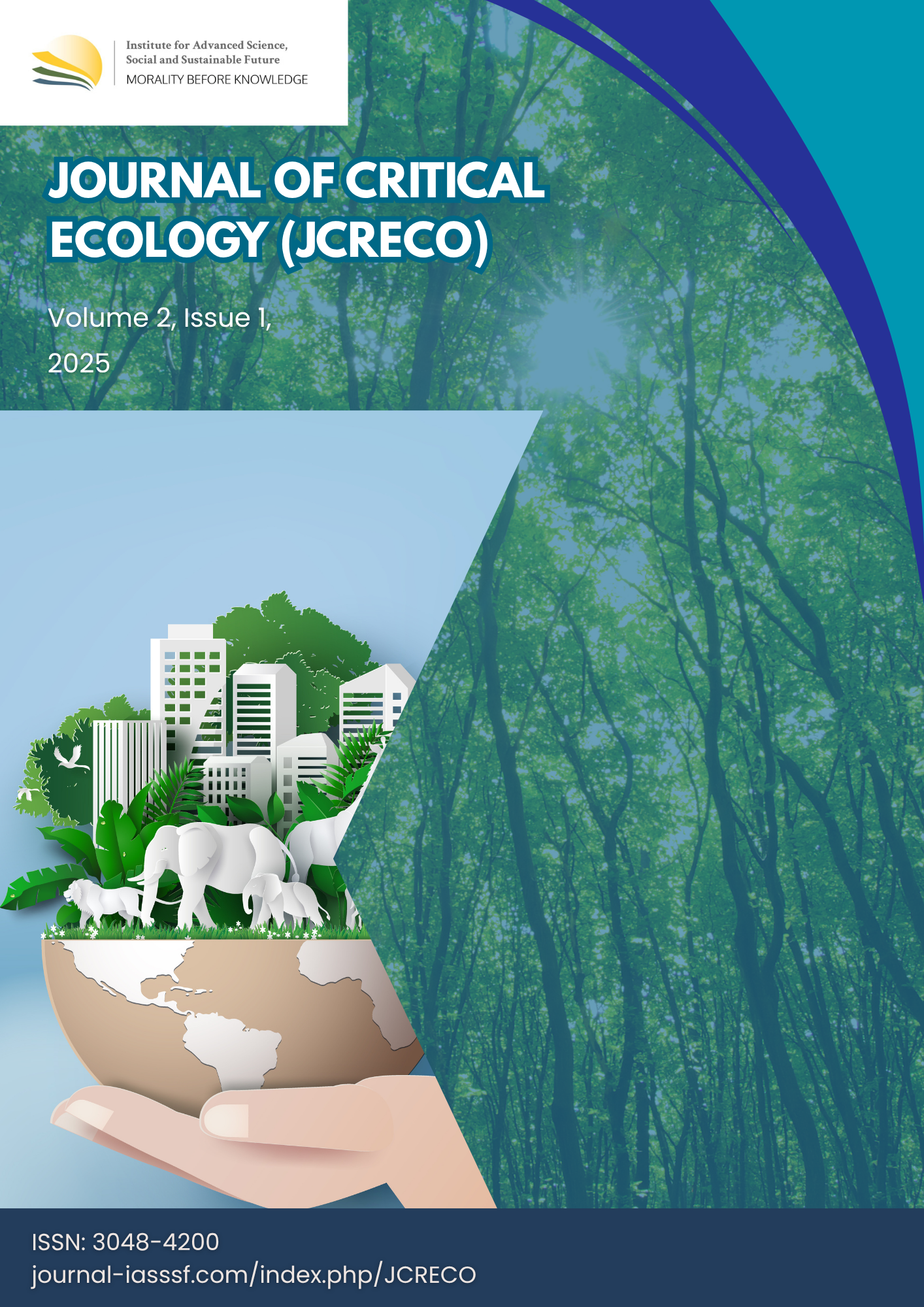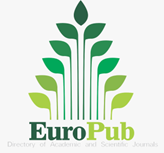Assessing the sustainability of community livelihoods: An ecological approach to enhancing livelihoods in forest area
DOI:
https://doi.org/10.61511/jcreco.v2i1.1741Keywords:
livelihood assets, strategy, sustainable livelihoodAbstract
Background: This study aims to assess the level of sustainable livelihoods in a village with significant natural resource potential, analyze the assets affecting the community's livelihoods, and propose strategies to enhance sustainability. Methods: This research was conducted in Piantus Village, Sejangkung District, over four weeks, using surveys, interviews, and questionnaires. A sample of 86 families from 598 was selected through Random Sampling. Descriptive analysis, processed with Microsoft Excel, assessed five livelihood assets: human, natural, social, financial, and physical. Findings: The results of this study indicate that based on the community livelihood asset indicator index in Piantus Village, Sejangkung District, Sambas Regency, the average index scale score obtained from community livelihood assets was 0.62 with moderate criteria which means not yet sustainable. Conclusion: The strategy carried out by the Piantus Village community is the Accumulation Strategy, the condition of the assets owned by the Piantus Village community is not yet sustainable and can be said to be relatively unsustainable so that accumulation needs to be carried out to improve its condition. Novelty/Originality of This Study: By incorporating both qualitative and quantitative methods, it provides fresh insights into the challenges and opportunities for enhancing livelihood sustainability in resource-dependent communities, offering a new strategic framework for ecological-driven livelihood improvement.
References
Aditiawati, P., Astuti, D. I., Suantika, G., & Simatupang, T. M. (2016). Development of local potential in Panawangan Village as a model of vocational village in community empowerment and increasing national food security. Journal of Sociotechnology, 15(1), 59–67. https://doi.org/10.5614/sostek.itbj.2016.15.1.6
Arman, R., & Hariyadi, H. (2017). Resilience of household livelihoods of former daily laborers on oil palm plantations in Sei Mangkei Village. Agrica Journal, 10(1), 36–43. https://doi.org/10.31289/agrica.v10i1.588
Arofah, I., & Rohimah, S. (2019). Path analysis for the influence of life expectancy, expected years of schooling, average years of schooling on the human development index through real expenditure per capita in East Nusa Tenggara Province. Jurnal Saintika Unpam: Jurnal Sains dan Matematika Unpam, 2(1), 76. https://doi.org/10.32493/jsmu.v2i1.2920
Baiquni. (2007). Livelihood strategies in times of crisis. Ideas Media.
Dharmawan, A. H. (2007). Rural livelihood and livelihood systems: The perspective of livelihood sociology from the Western school and the Bogor school. Sodality: Journal of Rural Sociology, 1(2). https://doi.org/10.22500/sodality.v1i2.5932
Farrington, J., Ramasut, T., & Walker, J. (2002). Sustainable livelihoods approaches in urban areas: General lessons, with illustrations. Overseas Development Institute.
Febriharjati, S., & Setyono, J. S. (2015). Sustainability of livelihoods of coffee farmers in Tlahab Village, Kledung District, Temanggung Regency. Urban and Regional Planning Techniques, 4(4), 605–621. https://doi.org/10.14710/tpwk.2015.9828
Fridayanti, N., & Dharmawan, A. H. (2013). Analysis of the structure and livelihood strategies of farmer households around the conservation forest area in Cipeuteuy Village, Sukabumi Regency. Sodality: Journal of Rural Sociology, 1(1), 26–36. https://doi.org/10.22500/sodality.v1i1.9388
Hidayat, M. A., Darmawan, B., & Putri, D. D. (2022). Sustainable livelihood strategy of asset-based community in cultivation of lemongrass in Kedungrandu Village, Patikraja District, Banyumas Regency. AGRITEXTS: Journal of Agricultural Extension, 46(1), 19–26. https://doi.org/10.20961/agritexts.v46i1.61451
Hogarth, N. J., Belcher, B., Campbell, B., & Stacey, N. (2013). The role of forest-related income in household economies and rural livelihoods in the border-region of Southern China. World Development, 43, 111–123. https://doi.org/10.1016/j.worlddev.2012.10.010
Kavanagh, P., & Pitcher, T. J. (2004). Implementing Microsoft Excel software for Rapfish: A technique for the rapid appraisal of fisheries status. Fisheries Center Research Reports, 12(2). https://doi.org/10.14288/1.0074801
Martopo, A. (2012). Study of sustainable livelihood level in Dieng Area (Case Study in Two Villages in Kejajar District, Wonosobo Regency). In National Seminar on Natural Resources and Environmental Management. https://repository.badankebijakan.kemkes.go.id/id/eprint/4855
Mulyani, I. (2020). Potential and challenges of empowering peatland communities: A study of sustainable life approaches in Tanjung Palas Village, Dumai Timur District, Dumai City. Community, 11(1), 1–20. https://doi.org/10.20414/komunitas.v11i1.1951
Nirwana, N., Yunita, Y., & Junaidi, Y. (2019). Sustainable livelihood strategy of Lebak swamp rice farmers in facing low income from rice farming in Naikan Tembakang Village, South Pemulutan District, Ogan Ilir Regency (Doctoral dissertation, Sriwijaya University). http://repository.unsri.ac.id/id/eprint/56696
Pradnyaswari, I. A. C., Wijayanti, W. P., & Subagiyo, A. (2022). Sustainable livelihood level of Purwakerti Village community, Karangasem Regency. Planning for Urban Region and Environment Journal (PURE, 11(3), 135–146. https://purejournal.ub.ac.id/index.php/pure/article/view/305
Rahmawati, I., & Rudiarto, I. (2022). Analysis of the welfare of Dieng Plateau farming communities using a sustainable livelihood approach. Journal of Environmental Science, 20(3), 637–645. https://doi.org/10.14710/jil.20.3.637-645
Rohmah, B. A. (2019). Sustainable livelihood strategy of the community in the dry land area of Karangpatihan Village, Balong District, Ponorogo Regency. Swara Bhumi-e, Geography Education Journal, Faculty of Social and Political Sciences, UNESA, 1(2), 1–10. https://ejournal.unesa.ac.id/index.php/swara-bhumi/article/view/28317
Roslinda, E., Sabathino, P., Pratama, Y. A., Supriadi, & Eva, J. (2024). Community livelihood assets of forest village management in Nanga Lauk Village, Kapuas Hulu District, West Kalimantan, Indonesia. Biodiversitas, 25, 664–672. https://doi.org/10.13057/biodiv/d250225
Sabiham, S., & Sukarman, S. (2012). Peatland management for oil palm development in Indonesia. Journal of Land Resources, 6(2). https://doi.org/133402.10.2017/jsdl.v6n2.2012.%p
Setyaningrum, A., & Nugroho, A. S. (2022). Sustainable livelihood strategy in fish processing communities during the COVID-19 pandemic (Case study in Poncosari Village, Srandakan District, Bantul). Journal of Marine and Fisheries Socioeconomics, 17(1), 115–123. https://doi.org/10.15578/jsekp.v17i1.10737
Sugiyono, D. (2010). Understanding qualitative research. CV. Alfabeta.
Syarifuddin, S., Putro, H. P. N., Arisanty, D., & Anis, M. Z. A. (2021). Community livelihood level in peat land, East Jejangkit Village, Jejangkit District, Barito Kuala Regency. EnviroScienteae, 17(1), 141–148. https://doi.org/10.20527/es.v17i1.11456
Tuhumury, R. A., Siegers, W. H., & Rasyid, A. (2015). Sustainable livelihoods of coastal communities in Tobati and Kayo Pulau Villages, Jayapura City. The Journal of Fisheries Development, 2(1), 21–38. https://core.ac.uk/outputs/229022230/
Virgin, P. A., Ayu, T., & Siregar, J. P. (2022). Comparative study of sustainable livelihood strategy of Kajoetangan Heritage Village and Tjelaket Ornament Village, Malang City. Journal of Social and Technology, 2(1), 13–30. https://doi.org/10.36418/jurnalsostech.v2i1.284
Wigati, S., & Fitrianto, A. R. (2013). Sustainable livelihood framework approach in order to dismantle the dominance of middlemen through religious activities: A case study on the assistance of PAR 2012 real work lectures in Luworo Village, Pilang Kenceng District, Madiun Regency. Journal of Dakwah: Communication Media and Dakwah, 14(2), 283–310. https://doi.org/10.14421/jd.2013.14207
Wulandari, P. S. (2017). Strategi Penghidupan Berkelanjutan Masyarakat Petani Berbasis Aset (Kasus di Dusun Sumberawan, Desa Toyomarto, Kecamatan Singosari, Kabupaten Malang). Universitas Brawijaya.
Downloads
Published
Issue
Section
Citation Check
License
Copyright (c) 2025 Supriadi, Emi Roslinda, Gusti Hardiansyah

This work is licensed under a Creative Commons Attribution 4.0 International License.















